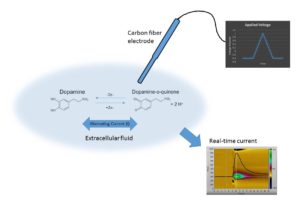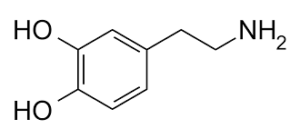Measuring Chemical Chatter
If a brain could talk, what would it say? Probably nothing profound or understandable. Rather, it would emit a bustling clamor of messages between neurons. These messages are delivered by chemicals called neurotransmitters. Different groups of neurotransmitters serve unique roles in the brain. Because there are so many chemicals sending so many messages, it’s often hard to know what each neurotransmitter group is saying. Scientists want to isolate the activity of individual neurotransmitter groups to better understand how these chemicals behave during both normal and abnormal behavior.
To decipher this chemical chatter, scientists use a technique called fast-scan cyclic voltammetry (FSCV). FSCV allows scientists to see real-time changes in neurotransmitter activity as an animal performs a behavior. It’s a way to correlate an individual’s behavior with a certain chemical’s activity. First, scientists insert an electrode into a brain area of interest. At the electrode’s tip is an incredibly thin carbon fiber — about the width of a strand of hair. Scientists then cycle the electrical potential at the carbon fiber tip up and down like a rollercoaster. This “cycling” helps the electrode detect specific neurotransmitters. As the electrical potential cycles up and down, the neurotransmitter is oxidized and reduced — a chemical process that can be measured as a current. The electrode is like a precise microphone, magnifying the murmur of a specific neurotransmitter’s activity amidst the din of other messengers.

Examining the Chatter
The shape of the electric current signal often differs between different neurotransmitters, allowing scientists to tell them apart. Computer programs then convert this electric current into a concentration that scientists can measure. Translating the oxidation/reduction reaction to current is much like translating foreign speech into a language you understand, and the shape of the current is much like an accent – an identifying feature of that language.
Once an electrode is in place and this translation process begins, scientists can examine how a neurotransmitter’s signal changes during certain behaviors, such as decision making. Afterward, sophisticated analyses measure the shape of the current signal to ensure that it is actually from a neurotransmitter, and not some other eavesdropping molecule or contaminant.
Why FSCV?

FSCV is incredibly useful in that it can specifically isolate and measure transmitters such as dopamine and serotonin. This is important because in many brain diseases, the chemical chatter of these neurotransmitters goes awry. For instance, dopamine deficiency is a symptom of Parkinson’s Disease, and schizophrenia often features imbalances in dopamine levels. Abnormalities in serotonin have classically been linked to depression (although that is being contested) as well as Sudden Infant Death Syndrome (SIDS).
Despite all this prior knowledge, scientists still don’t know exactly how these neurotransmitters contribute to different behaviors and diseases. As such, FSCV is a technique that furthers our understanding of how neurotransmitters behave. Scientists can use FSCV to examine how neurotransmitters function, both normally as well as in disease states, to help unlock the secrets of treating brain diseases.
Edited by Christina Marvin and Anginelle Alabanza.
Follow us on social media and never miss an article: